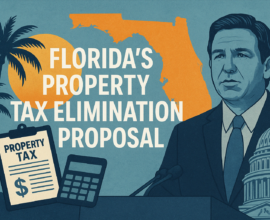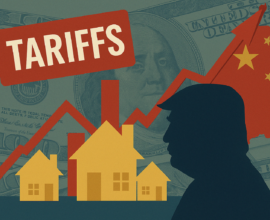1031 Tax Exchange: An Investor’s Guide to Unlocking Maximum Returns
Real estate investing is all about maximizing profits and minimizing costs. That’s why it’s essential to be aware of all the tax benefits available to you. If you’re a real estate investor looking to take your investments to the next level, you need to know about Section 1031 tax-deferred exchange.
This powerful tool can help you defer paying capital gains taxes on the sale of a property and reinvest the proceeds into a new investment property. Read on to learn more about this valuable opportunity and how it can benefit your investment portfolio. Don’t miss out on the chance to maximize your returns and minimize your tax burden!
The exchange allows you to sell a property and reinvest the proceeds in a new property while deferring the payment of capital gains tax on the sale of the original property
What is Section 1031 Tax-Deferred Exchange?
According to the IRS and Investopedia, a Section 1031 tax-deferred exchange is a tax planning strategy used by real estate investors to defer the recognition of capital gains tax on the sale of a property. The exchange allows you to sell a property and reinvest the proceeds in a new property while deferring the payment of capital gains tax on the sale of the original property. This is accomplished by executing a like-kind exchange under the guidelines set forth by the Internal Revenue Service (IRS).
To qualify for a Section 1031 tax-deferred exchange, the properties being exchanged must be used for business or investment purposes and must be of a “like-kind,” meaning they must be similar in nature or character. For example, an investment property can be exchanged for another investment property, but not for a personal residence. Additionally, there are strict time limits for completing the exchange, and the investor must work with a qualified intermediary to facilitate the transaction.
Consult with a tax professional or real estate attorney to ensure that the exchange is executed correctly and in compliance with IRS regulations.
A Step-by-Step Guide to Doing a Section 1031 Tax Deferred Exchange!
By following a step-by-step guide, investors can take advantage of the tax benefits offered by this strategy. The process involves:
- Identify properties. The first step is to identify the property you want to sell and the property you want to purchase as part of the exchange. Both properties must meet the IRS requirements for a like-kind exchange.
- Hire a qualified intermediary. A qualified intermediary is a neutral third party who facilitates the exchange by holding the proceeds from the sale of the first property and using those proceeds to purchase the replacement property.
- Execute the exchange agreement. The exchange agreement is a written contract between you and the qualified intermediary that outlines the terms of the exchange.
- Sell the first property. Close on the sale of the first property and have the proceeds held by the qualified intermediary.
- Purchase the replacement property. The qualified intermediary will use the proceeds from the sale of the first property to purchase the replacement property. The replacement property must be identified within 45 days of the sale of the first property and purchased within 180 days or by the due date of your tax return for the year of the sale, whichever is earlier.
- Complete the exchange The exchange is complete when the qualified intermediary transfers the ownership of the replacement property to you.
It’s important to note that the exchange must be completed within specific time frames and guidelines set forth by the IRS to defer the recognition of capital gains or losses on the sale of the property being exchanged.
Additionally, it is recommended that you consult with a tax professional or real estate attorney to ensure that the exchange is executed correctly and in compliance with IRS regulations. By becoming a premium subscriber with Property Onion, you gain access to professional help to streamline the exchange process.
A 1031 exchange allows real estate investors to diversify their investments by exchanging properties in one market for properties in another market.
Benefits of Section 1031 Tax-Deferred Exchange
A Section 1031 tax-deferred exchange, also known as a like-kind exchange, allows investors to defer paying capital gains taxes on the sale of an investment property by reinvesting the proceeds into a new property. The benefits of a 1031 exchange include:
- Deferral of Capital Gains Tax. The most significant benefit of a 1031 exchange is the ability to defer paying capital gains tax on the sale of a property. This can result in significant tax savings for the investor.
- Opportunity to Upgrade Properties. A 1031 exchange provides an opportunity for real estate investors to upgrade to a better investment property. By exchanging an older property for a newer one, the investor can take advantage of improved features and increased income potential.
- Diversification of Investments. A 1031 exchange allows real estate investors to diversify their investments by exchanging properties in one market for properties in another market.
- Increase in Cash Flow. A 1031 exchange can also result in an increase in cash flow through rental income from the replacement property.
- Deferral of Depreciation Recapture Tax. In addition to deferring capital gains tax, a 1031 exchange can also defer the payment of depreciation recapture tax, which is a tax on the portion of a property’s value that was claimed as depreciation deductions over time.
- Estate Tax Planning. A 1031 exchange can also be used as a tool for estate tax planning by allowing the property to be transferred to beneficiaries without triggering a taxable event.
The replacement property must be of equal or greater value than the property being sold. If the replacement property is of lower value, the capital gains tax will be recognized on the difference in value.
Potential Restrictions for Section 1031 Exchange
A Section 1031 tax-deferred exchange has specific restrictions and requirements set forth by the IRS. These restrictions include:
- Like-Kind Properties. The properties being exchanged must be considered like-kind, meaning they must be similar in nature or character and used for business or investment purposes.
- Timing Requirements. The exchange must be completed within specific time frames set forth by the IRS, including a 45-day identification period and a 180-day exchange period.
- Qualified Intermediary. A qualified intermediary must be used to facilitate the exchange and hold the proceeds from the sale of the first property.
- Maximum Purchase Price. The replacement property must be of equal or greater value than the property being sold. If the replacement property is of lower value, the capital gains tax will be recognized on the difference in value.
- Debt Requirements. The debt on the replacement property must be equal to or greater than the debt on the property being sold. If the debt on the replacement property is lower, the capital gains tax will be recognized on the difference in debt.
- Personal Use. The replacement property cannot be used for personal purposes, such as a vacation home. It must be used for business or investment purposes only.
- Tax Liens. The replacement property cannot have any outstanding tax liens.
How to Initiate a Section 1031 Tax-Deferred Exchange
Here is a step-by-step guide on how to initiate a Section 1031 tax-deferred exchange:
- Identify a property to sell. The first step is to identify the property that you wish to sell. This property must be used for business or investment purposes.
- Hire a qualified intermediary. A qualified intermediary must be hired to facilitate the exchange and hold the proceeds from the sale of the first property. The intermediary will provide a written agreement between you and the intermediary, known as an exchange agreement.
- Identify potential replacement properties. Within 45 days of selling the first property, you must identify potential replacement properties that meet the like-kind requirements set forth by the IRS. The identification must be in writing and must be signed by the taxpayer.
- Close on the sale of the first property. The first property must be sold, and the proceeds must be transferred to the qualified intermediary. The sale of the first property triggers the exchange period, which is 180 days or the due date of the taxpayer’s tax return for the year, including extensions.
- Acquire the replacement property. The replacement property must be acquired within the exchange period set forth by the IRS. The replacement property must be of equal or greater value than the first property and must have equal or greater debt.
- Close on the acquisition of the replacement property. The replacement property must be acquired, and the exchange must be completed within the exchange period.
- Receive the proceeds from the sale of the replacement property. The proceeds from the sale of the replacement property can be received by the taxpayer without recognizing any capital gains tax.
Failure to comply with the restrictions and guidelines set forth by the IRS can result in the loss of the tax-deferred benefits of the exchange.
By deferring capital gains taxes, you can retain more of your profits, reinvest them into a new property, and build wealth over time.
Increase the value of your portfolio!
In conclusion, a Section 1031 tax-deferred exchange can be a game-changer for real estate investors. By deferring capital gains taxes, you can retain more of your profits, reinvest them into a new property, and build wealth over time. This tax benefit can be a valuable tool for those looking to grow their investment portfolio and maximize their returns.
So, if you’re a real estate investor, don’t miss out on the chance to learn more about Section 1031 tax-deferred exchanges. Use this strategy to your advantage and achieve financial success. Don’t let this opportunity slip through your fingers, start exploring the benefits of a Section 1031 tax-deferred exchange today!









Very HELPFUL! Thank you Brianna!